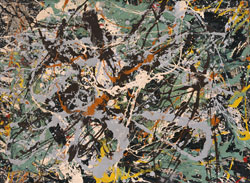1.6
Senior Years Activity
Conservation Case Study

Jackson POLLOCK
American 1912–56
Untitled (Green Silver) c. 1949
enamel and aluminium paint on paper, mounted on canvas
57.8 x 78.1 cm
Solomon R. Guggenheim Museum, New York
Gift, Sylvia and Joseph Slifka
© Jackson Pollock/ARS, New York. Licensed by VISCOPY Australia
2004.63
For |
Senior Years Students |
Curriculum |
VCE Studio Arts |
Aim |
To understand the issues surrounding the restoration of Jackson Pollock's Untitled (Green Silver). |
Preparation |
To do this activity you will need to:
|
Group Discussion: Technique |
Pollock has unconventionally combined alkyd (the American term for water based acrylic paint) with oil based paint onto paper. What in this case was the unintended consequence of this experimental combination of paints? How does this approach compare with that of an old master painter such as Rembrandt? Comment on the use of paint and the preparation of the surface. What was the final visual effect of the cleaning of Pollock's work? |
Group Discussion: Conservation |
Having read the article Restoring a Jackson Pollock by Guggenheim conservator Gillian McMillan: What do you think are the pros and cons of cleaning a painting in general, and in particular a Pollock? What is the difference between preventative conservation and a treatment such as this restoration? What examinations and tests did conservator Gillian McMillan use to determine the painting's condition? Define the terms matte, glossy and porous. Why did dirt stick to porous paint but not to glossy paint? List the various paint types and tools Jackson Pollock used in making Untitled (Green Silver). After carefully observing Jackson Pollock's Untitled (Green Silver), describe in approximately 20 words the surface quality and marks he made using this method. |
Group Discussion: Commentary |
Susan Davidson has written about the intense period between 1947 and 1950 when Pollock made Untitled (Green Silver): "Here, not only did Pollock move away from a reliance on traditional figuration and subject matter, but he broke free from the standard use of drawing and painting implements, usually abandoning their direct contact with the surface. Instead he worked from distances above the picture plane, using dripping, pouring, and splattering techniques – methods that were not necessarily Pollock's invention alone but that he pushed to new extremes". Discuss your opinion about this commentary. How does this commentary add to your understanding of the work? |